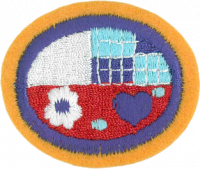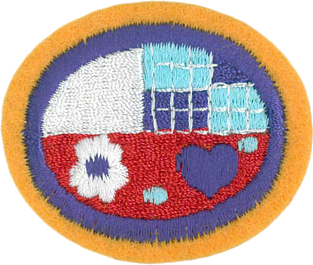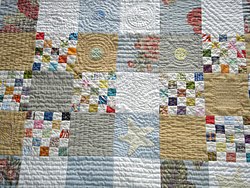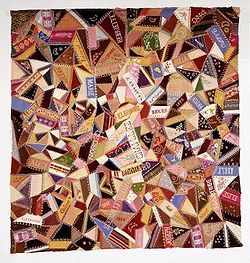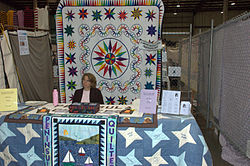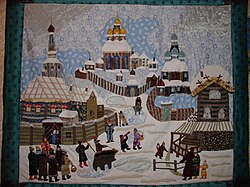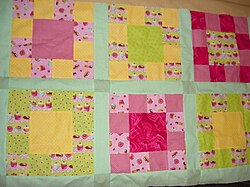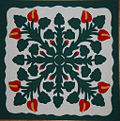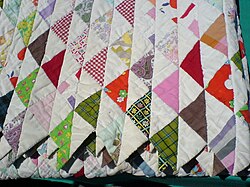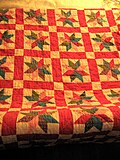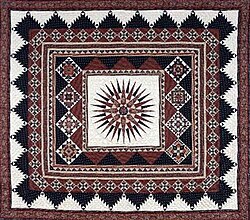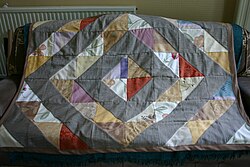AY Honor Quilting Answer Key used by General Conference
1
A quilt is a type of bedding— a bed covering composed of a quilt top, a layer of batting, and a layer of fabric for backing, generally combined using the technique of quilting. Another technique for securing the quilt layers is tying. Many quilts are made with decorative designs; indeed, some quilts are not used as bed covering at all, but are rather made to be hung on a wall or otherwise displayed.
2
The most common fibers used for a quilt's interlining are cotton, polyester, and wool.
3
Block Quilts
Block quilts are made by piecing rectangular (usually square) blocks of cloth together. This forms a regular pattern. The blocks may be decorated with fabric paint, appliqués, or other methods. They can be made from cloth with a single solid color or from prints.
Crazy Quilts
This art form was developed in United States during the 1880's when it created quite a stir. Crazy quilting does not actually refer to a specific kind of quilting (the needlework which binds two or more layers of fabric together), but a specific kind of patchwork. Crazy quilts rarely have the internal layer of batting that is part of what defines quilting as a textile technique.
Regular patchwork combines the pieces of fabric into a predetermined and regular design, but crazy patchwork uses irregular pieces of fabric on a foundation fabric or paper. This may create haphazard-looking and asymmetrical designs, or the designer may use some control in placement. The patches and seams are then usually heavily embellished.
Medallion Quilts
A medallion quilt starts with a center motif and is then surrounded by multiple boarders. The center is often a large square or star.
Pictorial Quilts
Pictorial Quilts are planned much like a painting. The artist would plan the colors and patterns of each part or item represented in the "picture" before beginning. Each piece would be cut carefully and then be stitched onto the quilt top to form the picture. Great care must be taken in piecing items in order (for example: for a nature scene, items in the foreground of the picture should be stitched on last.
4
Quilting is a sewing method done either by hand, by sewing machine, or by a longarm quilting system. The process uses a needle and thread to join two or more layers of material together to make a quilt. Typical quilting is done with three layers, the top fabric or quilt top, batting or insulating material and backing material. The quilter's hand or sewing machine passes the needle and thread through all layers and then brings the needle back up. The process is repeated across the entire piece where quilting is wanted. A straight or running stitch is commonly used and these stitches can be purely functional or decorative and elaborate.
Another technique for securing the quilt layers is tying. Tying refers to the technique of using thread, yarn or ribbon to pass through all three layers of the quilt at regular intervals. These "ties" hold the layers together during use and especially when the quilt is washed. This method is easier and more forgiving if the quilt is made by hand. Tied quilts are called, depending on the regional area, "lap", "comfort" or "comforter", among other names.
5
Traditional Quilting Processes
Traditional quilting is a six-step process that includes: 1) selecting a pattern, fabrics and batting; 2) measuring and cutting fabrics to the correct size to make blocks from the pattern; 3) piecing (sewing cut pieces of fabric together using a sewing machine or by hand to make blocks) blocks together to make a finished "top"; 4) layering the quilt top with batting and backing, to make a "quilt sandwich"; 5) quilting by hand or machine through all layers of the quilt sandwich; and 6) squaring up and trimming excess batting from the edges, machine sewing the binding to the front edges of the quilt and then hand-stitching the binding to the quilt backing. Note: If the quilt will be hung on the wall, there is an additional step: making and attaching the hanging sleeve.
Definitions
- Piecing: Sewing small pieces of cloth into patterns, called blocks, that are then sewn together to make a finished quilt top. These blocks may be sewn together, edge to edge, or separated by strips of cloth called sashing. Note: Whole cloth quilts typically are not pieced, but are made using a single piece of cloth for the quilt top.
- Layering: Placing the quilt top right side up atop the batting and the backing, which is right-side out.
- Quilting: Sewing the three quilt layers together, using stitches in decorative patterns, called motifs, or in utilitarian patterns, such as straight lines, using bigger stitches.
- Borders: Typically strips of fabric of various widths added to the perimeter of the pieced blocks to complete the quilt top. Note: borders may also be made up of simple or patterned blocks that are stitched together into a row, before being added to the quilt top.
- Binding: Fabric strips cut on the bias or straight of the grain, sewn together, making a long strip that will fit the perimeter of the quilt, which is typically machine sewn to the front side of the edge of the quilt, folded over, and hand sewn to the back side of the quilt.
- Quilting: Stitching through all three layers of the quilt sandwich, typically by hand or machine in decorative patterns, which serves three purposes: 1) to secure all three layers to each other, and 2) to add to the beauty and design of the finished quilt, and 3) to trap air within the quilted sections, making the quilt as a whole much warmer than its parts; for example, a single layer or all three layers used separately. Quilting is usually completed by starting from the middle, and moving outward toward the edges of the quilt. Examples: simple or complex geometric grids, "motifs" traced from published quilting patterns or traced pictures, complex repeated designs called tessellations, or stitching within the seam line itself, i.e., stitching in the ditch.
Note 1: Quilting can be elaborately decorative, comprising stitching fashioned into complex designs and patterns. The quilter may choose to emphasize and add to the richness of the quilting, by using threads that are multicolored and/or metallic, or that contrast highly to the fabric. Conversely, the quilter may choose to make the quilting disappear, using "invisible" nylon or polyester thread, and stitching in the ditch (in the seam line). Some quilters draw the quilting design on the quilt top before stitching, while others stitch "freehand."
Note 2: While the majority of quilt tops are pieced from many smaller patches of fabric (patchwork quilts), in which the patterns of individual blocks, or the pattern created by combining the blocks is the emphasis, whole cloth quilts typically use a single, non-figural piece of fabric and the elaborate quilting is the emphasis. Polished chintz, sateen or other shiny fabrics are often used in whole cloth quilts to aid in emphasizing the intricately detailed quilting stitches.
6
A good way to meet this requirement is to make a quilt as a club. Send each Pathfinder home with a square of cloth and instruct them to decorate and sign it. The squares can be decorated with appliques, fabric paint, tie-dye, or any other method that will survive the laundry. When everyone brings their squares in, proceed as described in the previous requirement.
7
